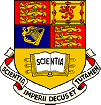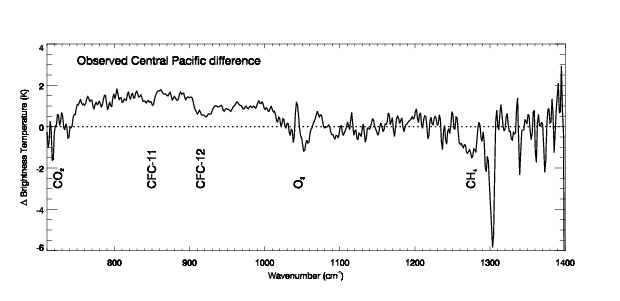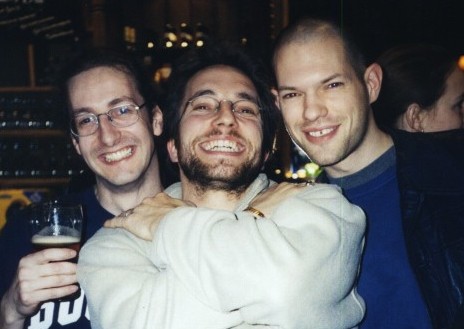
 |
|
News Page |

March 2001 |
This month's news stories:Greenhouse EffectPhD Successes From our Bologna correspondent |
 Greenhouse Effect Study Published in Nature
Greenhouse Effect Study Published in NatureWriting in this weeks copy of the journal Nature, a team from SPAT show that there has been a significant change in the Earth's greenhouse trapping over the last 30 years, a finding which is consistent with concerns over so-called 'radiative forcing' of the climate.
Previous attempts to quantify the effect of long-term increases in greenhouse gases on the spectrally resolved outgoing longwave radiation (OLR) have depended on theoretical simulations because of the paucity of data. In this new study, the SPAT team reached their conclusions after analysing data collected by the IRIS-D (Infrared Interferometric Spectrometer) and IMG (Interferometric Monitor of Greenhouse Gases) flown on polar-orbiting spacecraft in 1970 and 1997 respectively.
Comparison between the two data sets established that increases in greenhouse gas emissions from the Earth in the period between the two sets of observations have resulted in a change in the planet's clear-sky greenhouse trapping. Professor John Harries, the lead author of the paper says: "These unique satellite spectrometer data collected 27 years apart show for the first time that real spectral differences have been observed and that they can be attributed to changes in greenhouse gases over a long time period."
The paper generated extensive interest from the national and international media, with interviews being requested from Sky Television, BBC Radio 4, the Economist, the Independent, the Daily Express, USA Today, CNN, Toronto Daily Star, to name just a few! This was possibly due to the timely publication of the paper considering the US political decisions made on levels of greenhouse gas emissions on the same day.
Professor Harries described the remaining challenges for the team: "The next step is to assess whether these data can provide information about changes in not only the greenhouse gas forcing, but the cloud feedback, which is a response of the cloud field to that forcing.
"We are only at the beginning of making use of these spectral observations. Much more information is locked up in the data that we have. This provides a strong motivation for the launch of similar instruments to monitor the state of our climate."
Helen Brindley, Richard Bantges and Pretty Sagoo 19th March 2001
 PhD Successes
PhD SuccessesWe are very pleased to report that the 1997-2000 trio of PhD students from the Space side of SPAT all sumbitted their theses within three months of their nominal completion date and have since been successfully examined and duly passed. The three, pictured while celebrating, are from left to right Rob Wilson, Matt Taylor and Dorian Clack.
Matt was the first of the three to submit on 27th October, 2000, he tells me after 3 long years of blood, sweat and tears (and that was just from his PhD supervisor, Prof. Peter Cargill ). Matt's thesis concentrated on MHD modelling of space plasma, focussing mainly on the high altitude cusp region of the magnetosphere. The day after submission he moved to his new job as a Cluster research fellow at the Mullard Space Science Laboratory in Surrey, part of University College London. Following this he has managed to 1) Get married to his long suffering girlfriend, Leanne, on the 24th November (ahhhhhhhh). 2) Pass his viva on 11th December (woohoo). 3) Create a third member of the newly created family with Leanne. This person is due to arrive in September some time (ahhhhhhh). 4) Who knows... Matt says "PS Electron instruments produce an awfully large amount of data dont they!!!"
Dorian's oral examination took place on 25th January from which he emerged saying he "almost enjoyed it"! Dorian's thesis, supervised by Dr. Bob Forsyth, focussed on the magnetic field structure of Corotating Interaction Regions, the dominant large scale solar wind flow structures in the heliosphere at solar minimum. Dorian had a paper highlighted in Geophysical Research Letters in February 2000 on one aspect of his thesis work (SPAT News, March 2000). Dorian recently took up a post-doctoral position in the Center for Space Research at the Massachusetts Institute of Technology near Boston, where he is initially working on plasma data from the WIND spacecraft.
Finally Rob had his viva on 23rd February to complete the successful trio. His thesis on waves in the Jovian magnetosphere was supervised by Dr. Michele Dougherty. Rob too has moved to MSSL to work on Cluster - he couldn't escape Matt for long as they are now sharing an office!
Bob Forsyth 23rd March 2001
Prof. John Harries, SPAT head of group, is currently enjoying a few months sabbatical in Bologna, Italy. Here is his second report on his activities there, both professional and cultural...
 Letter No 2, Sunday 25 February 2001
Letter No 2, Sunday 25 February 2001Today is rather grey and very cold, but the past two to three weeks have been mainly sunny and clear: beautiful spring weather, with some flowers coming through in the gardens in the university. In those conditions, it really looks lovely here: the mustard or pink painted walls, the wonderful porticos, and, of course, the crazy 'due torri'.
Sheila and I have just got back in from our Sunday perambulations: we walked into the centre to buy 'La Republica' (Bologna is know as 'Red Bologna', apparently, both for its red bricks and for its politics), and then went for lunch in our favourite restaurant near the Santo Stefano churches. After lunch we walked to the Piazza Maggiore, where the 'Carnivale per Bambini' procession was taking place. Carnivale is the period leading up to Lent, when you are supposed to get rid of all high spirits before getting down to some serious fasting and giving up the good life during Lent. In some places, Venice for instance, Carnivale is wild, as adults put on masks and generally behave in ways which, I am told, they would not if unmasked. Hmm…. Here in red Bologna, the folks don't seem quite able to let their hair down that much, so it appears to be an occasion rather for dressing up the bambini in the most expensive costumes (Zorro is popular, as are the 101 (or however many) Dalmatians). And today there was a procession of floats around the Piazza Maggiore. It was freezing cold, but in true Italian style, a great party was had by all. Some of the little kidlets looked cute in their costumes, and the floats were very good. But, by golly, it was cold!
Next week we are off on the first serious trip away from Bologna. I am going to the Institute of Atmospheric Science in Rome, and the Institute for Electromagnetic Waves in Florence to give invited talks. A week or so later, I am going to the University of Basilicata (Potenza) to give another talk. That will mean going past, and visiting, Pompeii and a few other sights. All in the line of duty, of course. In our spare time we have taken to visiting more local places on Saturdays, since the trains are so cheap and so good. So far we have been to Florence, Ferrara, Parma, Verona and Rimini. All are very attractive, and some, like Florence and also Ferrara (which has fantastic castle, with really good dungeons!), are very much so.
Well our Nature paper proofs came last week, and were duly returned, so the greenhouse forcing paper should hit the streets soon. Generally on the work front, several things are going very well, though I realise now that I planned 2 or 3 times as much work as will be possible in the time. Those of you that work closely with me will know that this is not untypical!
Ciao!
PS We don't talk about Welsh rugby at the moment…..
John Harries 25th February 2001
Apologies for the lack of links on this page at the moment - I chose to put it up "as is" rather than delay it any longer. It will be tidied up in about a week's time!
View last month's news, older news or return to Space and Atmospheric Physics home page